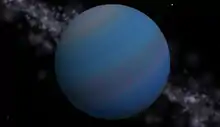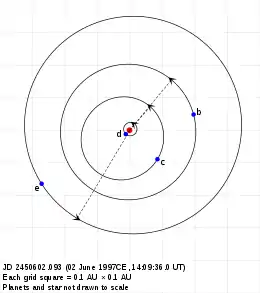Gliese 876 e
Gliese 876 e is an exoplanet orbiting the star Gliese 876 in the constellation of Aquarius. It is in a 1:2:4 Laplace resonance with the planets Gliese 876 c and Gliese 876 b: for each orbit of planet e, planet b completes two orbits and planet c completes four. This configuration is the second known example of a Laplace resonance after Jupiter's moons Io, Europa and Ganymede.[1]
 An artist's impression of Gliese 876 e | |
| Discovery | |
|---|---|
| Discovered by | Rivera et al. |
| Discovery date | June 23, 2010 |
| Doppler spectroscopy | |
| Orbital characteristics | |
| Epoch HJD 2,450,602.093 | |
| 0.3343 ± 0.0013 [1] AU | |
| Eccentricity | 0.055 ± 0.012 [1] |
| 124.26 ± 0.70 [1] d | |
| 335 ± 24 [1] | |
| Inclination | 59.5 [1] |
| 239 ± 22 [1] | |
| Semi-amplitude | 3.42 ± 0.39 [1] |
| Star | Gliese 876 |
| Physical characteristics | |
| Mass | 14.6 ± 1.7 [1] M⊕ |

Gliese 876 e has a mass similar to that of the planet Uranus. Its orbit takes 124 days to complete, or roughly one third of a year. While the orbital period is longer than that of Mercury around the Sun, the lower mass of the host star relative to the Sun means the planet's orbit has a slightly smaller semimajor axis. Unlike Mercury, Gliese 876 e has a nearly circular orbit with an eccentricity of 0.055 ± 0.012.[1]
This planet, like b and c, has likely migrated inward.[2]
References
- Rivera, Eugenio J.; et al. (July 2010). "The Lick-Carnegie Exoplanet Survey: A Uranus-mass Fourth Planet for GJ 876 in an Extrasolar Laplace Configuration". The Astrophysical Journal. 719 (1): 890–899. arXiv:1006.4244. Bibcode:2010ApJ...719..890R. doi:10.1088/0004-637X/719/1/890.
- Gerlach, Enrico; Haghighipour, Nader (2012). "Can GJ 876 host four planets in resonance?". Celestial Mechanics and Dynamical Astronomy. 113 (1): 35–47. arXiv:1202.5865. Bibcode:2012CeMDA.113...35G. doi:10.1007/s10569-012-9408-0.